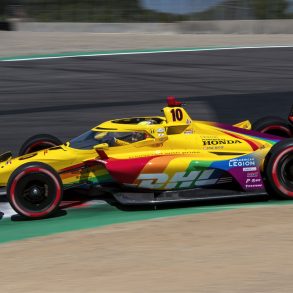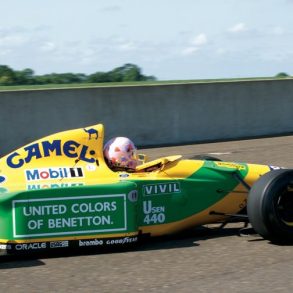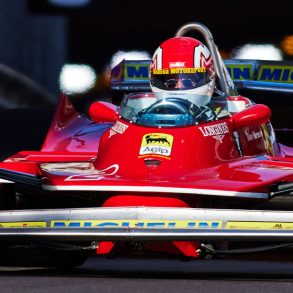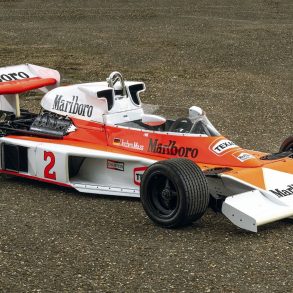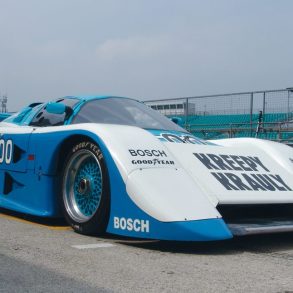René Dreyfus Biography

Forging his mother’s signature René entered his first race and won, due in large part to his being the only car in his class. During this time he and his brother Maurice owned a paper company with René acting as the salesman. He somehow convinced his mother that if he had a Bugatti he would be able to get around faster and see more customers. His mother was duped and soon the boys had their first race car.
During the 20’s and 30’s he drove Maseratis, Ferraris and especially Bugattis on the Grand Prix circuits of the world. In 1930 after a successful inaugural race the second running of the Grand Prix of Monaco saw a contingent of factory and private Bugattis. One of the private entries was driven by an amateur driving who had recently scored some local victories. His name was René Dreyfus, but in 1931, Louis Chiron and the winner of the first Monaco Grand Prix, Williams were the clear favorites. Prior to the race Dreyfus figured he could run the entire race without having to pit if he had an auxiliary fuel tank fitted to his car.
His team recommended against trying to run the complete race non-stop fearing that fatigue from the tight circuit would make that impossible. Dreyfus was adamant and the rest of the team finally relented and an auxiliary tank was fitted. The start of the race saw Chiron vaulting into the lead but back in the pack something quite unexpected was happening. Private entrant René Dreyfus then in seventh began his charge to the front. By the end of the fifteenth lap he was third, the end of the fortieth saw him in second. Slowly he was catching Chiron but the end of the race was approaching and it looked that Dreyfus would have to settle for a well deserved second.
Just then both Bugattis fuel tanks read empty and Chiron dove into the pits, Dreyfus blithely opened the faucet to his auxiliary fuel tank and continued his race. Chiron was able to resume his race still in first but now his lead had shrunk and in his mirrors was Dreyfus. To make matters worst Chiron was now suffering from a sticking throttle and soon Dreyfus was past. The crowd at first disappointed that their native son, Chiron, had lost his lead began to cheer this private entrant. When the flag finally fell the gap between first and second was twenty-two seconds and Dreyfus had won his greatest victory of his young career.
In the coming years, with the appearance of new cars from Mercedes and Auto Union, René finds himself at the center of the greatest period in the history of Grand Prix racing. His contemporaries included Chiron, Caracciola, Varzi and Nuvolari. He always had a special admiration for Tazio Nuvolari.
“He talked to his cars,” René Dreyfus remembers, “and they answered! It was incredible. He would jump from side to side, put his whole body into the effort. It seemed to me sometimes that he was himself physically lifting the car – over a curb, for example, to take a corner faster. We’d ask ourselves often, how he can drive that way? That’s not right. But then he’d win …”
France, the birthplace of motor sport, was now behind the Italians and the resurgent Germans in the Grand Prix pecking order. In an effort to reverse their fortunes the French government instituted the Prix du Million to encourage constructors to build new cars. The prize was a million francs to be awarded to the French car and driver winning a race against the clock at the famed Montlhéry circuit. For the speed attempt Dreyfus drove a specially prepared Delahaye. The peculiar rules stated that the car must do 200 kilometers at an average speed of at least 146 km/h from a standing start. The difference in this race over others was that only the clock was your opponent and the clock never made a mistake.
Everyday that summer they tested and when the day finally came there was a large crowd including reporters from all of the major newspapers. After the standing start there would be no turning back without a tremendous loss of face. He was off – faster and faster he drove trying to raise the average speed to the magic number. Through the curve where the great Antonio Ascari had lost his life he dared not lift his foot. By mid distance he was there, but on lap 13 disaster struck. The Dunlop tires were showing the white warning strip and the Dunlop man was gesturing for Dreyfus to abandon the attempt. Nothing could stop Dreyfus now, he had come too far. On lap sixteen the flag fell and the deed was done.
The Million was his and only Bugatti had a chance to best his time. Reports from Molsheim told of a special car being prepared for Jean-Pierre Wimille that would grab the prize just won by Delahaye. The deadline for the competition was the 31st of August, only a few days away, and still no Bugatti. Finally on the last day the men from Molsheim arrived. At four in the afternoon the Bugatti was off but after a few laps it came in with a broken rear axle. The mechanics pounced on the car and had the axle replaced within an hour. Off they went again before being stopped with a fouled plug. The shadows were getting longer and Wimille was about to call it quits when Jean Bugatti ordered him out once more.
With a screech of tires he was off again desperate to beat the Delahaye. Dreyfus meanwhile was back on the track determined that if he were to lose the competition it would be while he was on the track rather than as a spectator. Both cars tore around the track each oblivious of the other as they strained at the limit. The Bugatti was the first to crack as evidenced by a wisp of smoke and by the next lap it was off to the side. René Dreyfus had won the day.

A French driver with a Jewish name driving a French car beating the Mercedes of Caracciola caused a sensation. Unfortunately it was that same Jewish name that would prevent Dreyfus from ever having a chance to drive for Auto Union or Mercedes unlike his friend Chiron. Dreyfus remembered the situation
“What was happening in Europe now was incredible too. Things were changing cataclysmically, but it seemed as if we were trying to pretend they weren’t. In racing circles, we had been aware of, but somewhat apart from, the political situation. Certainly we saw the swastikas, we heard the fascist songs, we were neither blind nor deaf. And during the last year past, because we were often on the road to events in Germany, we could see the movement of troops and we could sense the military buildup. But as drivers, we were simply French, Germans, Italians and British, and we were all friends. … We didn’t talk about the war at Nurburgring. Still it was apparent to me that I was being treated preferentially, by the German drivers, by the officials, by everyone at Nurburgring. A Frenchman with a Jewish name on German soil. I was perhaps a reminder, an omen of what lay ahead. Maybe we all wanted to postpone thinking about it. I was given every courtesy.” In his pocket Dreyfus had papers ordering him to report to his Army unit shortly after the race.”

The year was 1940 and with little preparation he was set to qualify for the race ... Next came qualifying. We were told what that was, and that we had only Sunday to do it. No problem, we thought, and we asked the necessary speed: 127 mph had been the maximum, we were told, but 118 would be more than enough to make the field. The field, as traditionally, would be thirty-three cars. Réne Le Begue went out and did 118.981; I went out after him and did likewise, 118.831. When I came in, my car was surrounded by a mass of Speedway officials asking me frantically why I hadn’t stopped on the penultimate lap to try again as the rules allowed. Why would I want to stop, I said, I had watched my rev counter, I knew precisely the speed I was doing. Enough to qualify.
Don’t you understand they implored me. And then they explained the practice of bumping. I had just qualified thirty-third, the last position in the field; someone could go out on the track now, put up a speed a hundredth of a second faster than mine and “bump” me out of the race. And that is exactly what happened as I stood there. Now I was the one who was frantic, and angry. And I was both at the top of my lungs. Why didn’t you tell me, I screamed, I would have gone faster. I was only saving my engine. In Europe, you entered and if you were accepted, you raced. Qualifying didn’t exist and though I comprehended what that was, bumping didn’t translate at all. It made no sense.

This was the end for my car. But there seemed to be a simple solution for me. As team captain, I would take over the car of Réne Le Begue who had qualified-thirty-third as it turned out after all the qualifying and bumping was over. No, you cannot do that. Why not? Because your car was entered with you as driver, Réne Le Begue as co-driver. Réne Le Begue’s car was entered with himself as driver, you as co-driver. In that car, Ren6 Le Begue must start the race. This again was completely contrary to European practice.
It was all terribly confusing. Ultimately, Réne Le Begue and I decided that he would drive the first 250 miles, I would drive the last 250. That seemed simple enough. And that was okay, according to the rules. And so we retired to the Duesenberg garage to work on the cars. Gasoline Alley didn’t afford the equipment we needed for repairs, and Augie Duesenberg generously offered their facilities. Already we were learning of mistakes we had made in preparation. Our rear axle ratio, for example, was wrong. In Europe, all we knew of the Indianapolis track was the speed reached on the straights, and we assumed we would have to downshift for turns. Not so. American drivers had a different ratio, revved a little higher on the straight, lifted the foot and took a turn without having to change gears. And probably some of them had a special gear ratio just for that race just for that track.

My car was somewhat better than Réne Le Begue’s, so we replaced some parts. But only some. Others we weren’t allowed to. Through the night-I wasn’t there all the time, but Harry and Luigi told me afterward-while the car was being worked on, officials stood by and watched to see that we were not doing something we shouldn’t.
More press interviews followed. The French Army had given me some pictures of myself in uniform, which Bernard passed on to reporters, and photographers got the idea of posing me similarly in the Maserati for juxtaposed newsphotos headlined, “Over Here, Over There” and captioned “Brigadier Réne Dreyfus … wheel in hand… gun in hand.”
Then Réne Le Begue and I attended the driver’s meeting. We didn’t understand a word of what was going on. But we weren’t apprehensive. Basically, once a race started, it had to be pretty much the same all over the world. You start, you drive, and you-hopefully-finish. And you glance at your pit for lap or flag signals.

Our plan now was to move up a few places and finish among the first half-dozen cars, which we thought would be a good performance. I got in, took a few laps to become comfortable with the car, regained our tenth position, it started to rain, and I proceeded with the plan. I passed one car, I passed another car. It was easy; the Americans were driving so slowly. I couldn’t understand it, could it possibly be that they were afraid of the rain?
Then I was signaled to come to the pits and was told that I could not pass because it was raining, that was the rule. Oh, I said. Another new rule. I went back out and dutifully positioned myself behind the driver who had been ahead of me-and stayed there. Had I not had my driving gloves on, I would have been biting my fingers. We were cruising around the course so slowly, perhaps only a hundred miles an hour. Then the rain stopped, and I thought, now’s my chance, we go back to the plan. I passed one fellow, and another fellow-and I was flagged into the pits again. If you do that once more, I was warned, you’ll be out of the race. Do what?, I said, it isn’t raining anymore. They said, yes, it is true, it isn’t raining anymore, but the track is still wet, and why didn’t you look at the traffic lights.
“This was history, true, but it was the coming full circle of my life as well.” René Dreyfus
What traffic lights? They were pointed out to me for the first time, above the track. I had never seen them before, the days previous had been so busy with practicing and trying to figure out how Americans qualified their cars, and I hadn’t looked up and noticed them. By now the race was nearly over. After all the explanations, I went back out, regained tenth position and that’s where we finished. I was a nervous wreck. Wilbur Shaw won the 500 again with the same Boyle Special Maserati he had the year before. Afterwards, everyone was very kind. Bob Honkinson in Motor Age wrote that we “did a swell job” and deserved “unstinted praise” and we were heartily congratulated all around. Still, I was disappointed. We could have finished fifth or sixth, if it hadn’t rained. Our day at Indy brought about $1,400 in prize money.

The war was finally over but for Dreyfus his life had changed. He returned to the United States and became an American citizen. He opened his famous New York restaurant, Le Chanteclair. It became a haven to the International racing set. Through its doors passed all the greatest drivers including those from René’s past including Achille Varzi and Rudi Caracciola. Shortly after the war he heard his name called in a booming German accented voice. It was Alfred Neubauer, the legendary team manager of Mercedes, and together they talked into the early morning hours about days gone by and the current situation in motor sport.
In 1980 the circle was completed when he returned to Europe to celebrate the 50th anniversary of his victory in the Grand Prix of Monaco. It was a journey back to his youth as he visited all of the old places and was feted at each stop. Along with his brother Maurice and author Beverly Rae Kimes they drove down the Riviera towards Monaco. Even though he was well into his 70’s he would not think of anyone driving but himself. After taking his tour d’honneur and watching the race he was called to the stage at the banquet that night.
On stage were two cars, one the Bugatti of 1930, the other the current race winner, Williams. The master of ceremonies Jackie Stewart called on Dreyfus and the new winner Carlos Reutemann to their cars. As he sat in his car he glanced at the reserved Reutemann who was smiling broadly and a wave of emotion overwhelmed René. He could see all the great drivers and all of the fantastic places that would never be again.





